Before the highly anticipated Great American Total Solar Eclipse in August, there will be a Meteor Shower this month. Students, scholars, scientists, and enthusiasts can enjoy the Delta Aquariid meteor shower on its peak on July 28 or July 29.
Delta Aquariid will usher in the annual Perseids meteor shower in August. Delta is longer and lesser compared to Perseids. It will peak later this month, meaning a high number of Shooting stars will be visible in the sky starting July 27 or 28.
Meteor Shower
The Delta Aquariid meteor shower lingers longer. It will start by July 12 and may continue until August 23, according to EarthSky.Org.
It may even overlap August's full moon on the 7th. But don't worry, the moon will set late during these days, which means there will be a moon-free sky from midnight to dawn. This will be a good window to go watch the meteor shower. Showers usually produce the most number of meteors during predawn hours.
How to watch the meteor shower
On July 27, 28 or 29, the moon will set by midnight. Once the sky is moon-free it is the best time to look for meteors in the sky. Experts say that the best time to watch shooting stars this month is around 2:00 am. This window is applicable anywhere in the world.
However, astronomers remind the public that the Delta Aquariid meteor shower won't be as grand as the Perseids.
This is the reason why darker skies are more suitable for watching this month's meteor shower. The Southern Hemisphere will be the most conducive spot to watch Delta Aquariid. Stargazers near the mid-northern latitudes will also see the meteors.
Based on history, the peak of the shower can yield up to 10 to 20 meteors per hour if there's a dark sky and if a person is watching away from light pollution. Although fainter, most of the meteors will leave a trail making it visible. The trails are made up of glowing ionized gas that will last for about one to seconds while the meteor is passing by.
The rocks produce the trail because they burn up in the sky at about 60 miles (100 kilometers) on top of the Earth's surface.
When it reacts with the atmosphere, a burning and glowing trail is produced.
The meteor shower is named after the star called Skat, also known as Delta Aquarii. The meteors will come from the south. In August, the two showers may overlap. To identify them, the Perseids will come overhead while Delta Aquariid will come from the northern horizon if the person viewing them is in the southern hemisphere.
Origin
Meteor showers occur when the Earth's orbit passes through remnants or debris of a Comet. The comet particles that broke off due to the heat of the sun interact with the planet's atmosphere causing a natural celestial light show. The comet debris turns into meteors, also known as shooting stars.
It is believed that the meteors that will come this month originated from Comet 96P Machholz. However, the parent body is not confirmed yet. It was discovered by Donald Machholz in 1986.


